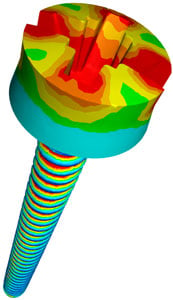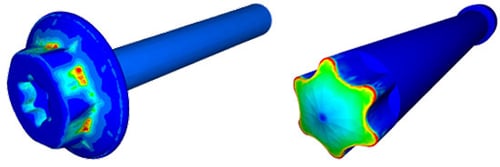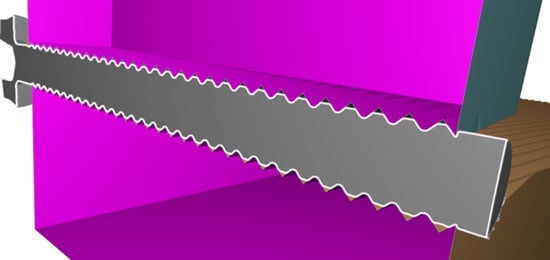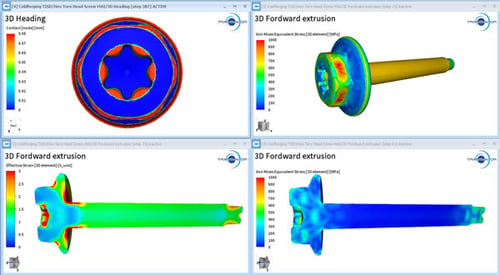Optimize your metal fasteners
 Screws, bolts, nuts, washers, rivets, studs, etc. metal fasteners are sometimes critical parts since their level of quality guarantees the safety and high impact resistance of final parts, in particular in the automotive industry.
Screws, bolts, nuts, washers, rivets, studs, etc. metal fasteners are sometimes critical parts since their level of quality guarantees the safety and high impact resistance of final parts, in particular in the automotive industry.
Developing the right fastening solution involves engineering challenges: defining the forming sequence, reducing production costs, respecting the desired geometry and weight, improving product performance, preserving tooling, etc.
Digital simulation is therefore required upstream of production in order to analyze and optimize your process and the final product. It also reduces development time and costs of testing and production.
Simulation for the production of fasteners
Simulation helps master all stages of the manufacturing process for fasteners, from wire drawing to shearing, cold forming, then rolling of threads to heat treatment.
Taking phosphatized surfaces into account
The use of phosphatized steel reduces wear on tools and dies. The phosphatized surface of the wire can be taken into consideration during data setup.

Phosphatizing feature available in COLDFORM®
Integration of initial plastic deformation induced by wire drawing
Upstream of cold forming operations, the wire is drawn to form coils of the required diameter. Generally, the drawn wire then undergoes a heat treatment called spheroidization annealing. If this heat treatment is not applied, the plastic deformation induced by wire drawing should be taken into account in the simulation. COLDFORM® can initialize the fields along an axis or a radius. This feature allows the initial plastic deformation along the radius of the billet to be defined.
Application for unannealed wire before forming:

Left: Initialization of the plastic deformation
Right: Comparison of the tonnage obtained by forming a pre-drawn and annealed wire
Bar shearing
The second step of the process that can be simulated is the shearing of the metal wire necessary for the manufacture of small billets.
Our software measures the necessary shear force according to the thickness of the wire, the material, the parameters of the machine, etc.
The sheared surface is accurately predicted using the adaptive remeshing technique.
Billet shearing simulation. Courtesy of Hatebur.
Forging sequence
The striking range is then developed to ensure at each stage a good distribution of the material, the absence of defects and well-balanced striking forces. The steps are defined in COLDFORM® and different types of results can be analyzed:
- On the part: the final geometry taking into account the springback, the flow of material in the cavity, the appearance and development of defects (folds, cracks, under-filling, suction defects, poor fibering, etc.), internal stresses, temperature, hardness, etc.
- On the dies: abrasive wear, internal stresses, fatigue, etc.
- On the press: tonnage

Case study: Forging sequence for a hexagon head screw
This example shows a forging sequence for the manufacture of a screw, carried out by the Miguel Altuna Institute (Spain). The process was broken down into 5 steps on COLDFORM®:
- Front extrusion
- Head forming
- Reduction of the hexagonal head
- Head forming + rear extrusion
- Front extrusion
The first three stages were the subject of a 2D simulation (axisymmetric revolution part) and the last two stages were simulated in 3D
Modeling of all stages of the forging sequence
The deformation, stresses, temperature, etc. can be analyzed for each step of the sequence.

Torx hex head screw forging sequence. Real part vs. Simulation of metal flow and mechanical properties at every stage.
Courtesy of Miguel Altuna Institute Spain
Thread rolling
COLDFORM® also simulates the creation of threads around the screw. The contact algorithm and the temporal integration diagram make the simulation of the threading totally predictive: the software models the actual kinematics applied to the chaser and highlights the internal and external stresses.
Modeling of the increase in equivalent stresses during threading
Courtesy of the Miguel Altuna Institute
By using a cutting plane, it is possible to anticipate the areas of underfill on the screw thread.

Highlighting of under-filled areas on the thread
Heat treatment
The fasteners must guarantee an excellent level of resistance since they are often used in areas with high tensile stress. To achieve the desired metallurgical and mechanical properties, manufacturers apply heat treatment such as heating, quenching and tempering.
Following your cold forming simulation on COLDFORM®, this operation can be simulated with our SIMHEAT® software.
 Changes in the hardness of a screw after the tempering operation
Changes in the hardness of a screw after the tempering operation
COLDFORM® competitive features for fasteners
- Materials database with more than 250 characterized references for cold forming. Compatibility with JMatPro material databases.
- Cold rheology generation tool to create your own material file.
- Springback prediction thanks to the last increment of COLDFORM® which measures the displacement due to springback.

The blue meshing corresponds to the increment of the last forming step. The part in gray corresponds to the springback increment. The displacement due to springback is therefore easily visualized.
- Marking feature to visualize fibering Fiber changes can be modeled at each stage of the forging process and can be defined in “Data setup” or “Analysis” mode.
 Changes in fibering at each cold forming step
Changes in fibering at each cold forming step
- Integrated damage and failure criteria (Latham & Cockroft, Oyane, Ryce & Tracey, Chaboche-Lemaitre, etc.).
- Multi-view windows to easily display and compare different results and different viewing angles at the same time. Possibility to display up to nine windows simultaneously.

Multi-view display of a given case
- Preset curves to create a specific pattern. For example: load over time.
- Analysis of the stresses on the tooling to avoid the risk of breakage and improve the life of the dies. Find out more
- Metallurgical analysis to guarantee mechanical and metallurgical properties (grain structure).
- Interoperability with SIMHEAT® software to model the heat treatment step after forming. Find out more




